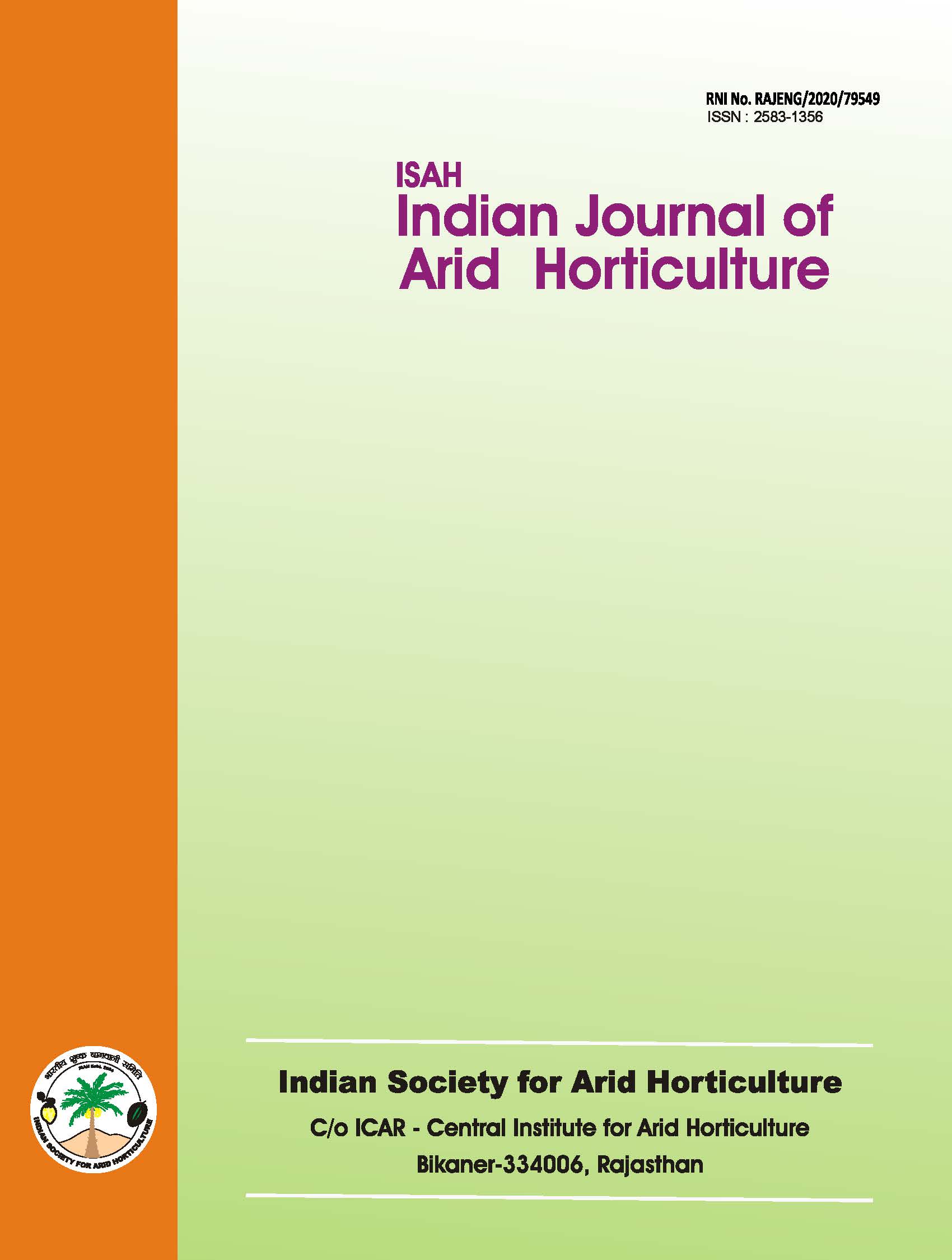Epidemiological Studies on Powdery Mildew (Oidium erysiphoides f. sp. ziziphi) of Ber in Scarce Rainfall Zone of Andhra Pradesh
Keywords:
Ber, epidemiology, powdery mildew, pathogen, abiotic factorsAbstract
Ber, known as the king of arid fruits, is an ancient fruit crop cultivated in arid and semi-arid regions of India. Powdery mildew, caused by Oidium erysiphoides f. sp. ziziphi Yen and Wang, is a significant limiting factor in the successful cultivation of ber. To study the effect of different abiotic environmental factors on disease development, a field experiment was conducted from 1998 to 2015 on ber cultivar Gola. Based on the epidemiological studies on ber powdery mildew, it was concluded that disease initiation occurred during the 35th or 36th standard meteorological weeks. The disease was significantly and negatively correlated with minimum temperature (<23.60°C) and rainfall (<24.76 mm) and positively correlated with relative humidity (>76.32%) and sunshine hours (>5.39 hours).Downloads
References
Balasubramanian, M., & Jeyarajan, R. (1997). Effect of weather factors on powdery mildew incidence in grapevine. Journal of Mycology and Plant Pathology, 27(2), 225-226.
Chavan, S.B., Khandge, S.V., Varshneya, M.C., & Patil, J.D. (1995). Influence of weather parameters on conidia formation in powdery mildew of grape. Indian Phytopathology, 48(1), 40-44.
Jahagirdar, Shamarao, Venkatesh, H., & Jamadar, M.M. (2001). Influence of antecedent weather variables on powdery mildew of grapes in Northern Karnataka. Paper presented at the National Seminar on Agrometeorological Research for Sustainable Agricultural Production, GAU Anand, September 27-28, 2001.
Kat, R.C., & Goyal, S.K. (2009). Epidemiological studies on powdery mildew of ber (Ziziphus mauritiana Lamarck). Acta Horticulturae, 840, 439-446.
Jacob, D., David, D.R., Sijenberg, A., & Elad, Y. (2008). Conditions for development of powdery mildew of tomato caused by Oidium neolycopersici. Phytopathology, 98(3), 270-281.
McKinney, H.H. (1923). A new system of grading plant disease. Journal of Agricultural Research, 26, 195-218.
Pandey, V., Patel, D.S., Patel, B.M., & Patel, S.J. (2004). Effect of weather variables on outbreak and spread of powdery mildew disease in ber. Journal of Agrometeorology, 6, 124-126.
Pareek, O.P., & Nath, V. (1996). Ber: In Coordinated Fruit Research in the Indian Arid Zone – A Two-Decade Profile (1976-1995). National Research Centre for Arid Horticulture, Bikaner, India, pp. 9-30.
Rakhonde, P.N., Wadaskar, R.M., Koche, M.D., & Anvikar, D.G. (2011). Influence of weather parameters on powdery mildew (Erysiphe polygoni) in green gram. Crop Research, Hisar, 42(1-3), 344-347.
Sankar, N.R., & Sreeramula, A. (2008). Morphological characterization and the effect of temperature and relative humidity on the development of ber powdery mildew. Journal of Plant Disease Sciences, 3(2), 151-154.
Sharma, S. (2003). Relationship of rainfall with powdery mildew (Oidium erysiphoides f. sp. zizyphi) of jujube (Ziziphus mauritiana). Indian Journal of Agricultural Sciences, 73, 636-638.
Sharifi, M.H., Zad, J., Tehrani, A.S., Okhowat, S.M., & Safarnejad, A. (2006). Effect of temperature and relative humidity on germination of ascospores and conidia of Uncinula necator, the causal agent of grape powdery mildew. Iranian Journal of Agricultural Sciences, 37(3), 457-496.
Thind, S.K., Nirmaljit, K., & Aulakh, J.K. (2004). Periodicity and epidemiology of ber powdery mildew in Punjab. Progressive Horticulture, 36(1), 164-166.
Venkatesh, M., & Jamadar, M.M. (2001). Meteorological influence on incidence of powdery mildew on ber (Ziziphus mauritiana Lamk.) in the Northern Dry Zone of Karnataka. Paper presented at the National Seminar on Eco-friendly Approaches for Plant Disease Management.

